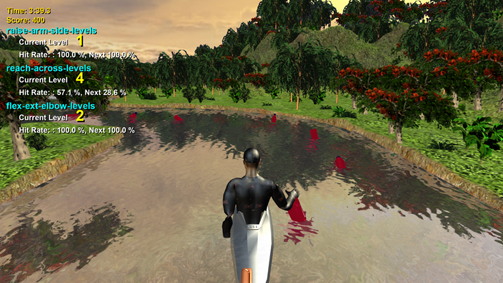Kinect powers cost-effective stroke therapy
Imagine how your life would change if you couldn’t easily move the arm and hand on one side of your body. For more than 2 million Americans, this scenario requires no imagination: it's their reality, brought on by a stroke, brain injury, multiple sclerosis, cerebral palsy, or some other neurological condition. Physical therapy can help these people, but professional treatments are often time-limited and expensive, and they frequently lack sufficient intensity to create lasting change.
Recognizing the need for an effective, affordable home therapy, a team at The Ohio State University has developed a therapeutic game called Recovery Rapids—and we’re pleased to note that the Kinect sensor is an important part of this ingenious solution. Recovery Rapids is based on constraint-induced movement therapy (CI therapy), a method shown to produce improvement in patients regardless of their age or how long ago the injury occurred. CI therapy discourages use of the unaffected arm, and focuses on using the weakened intensively to complete prescribed tasks.
[View:https://www.youtube.com/watch?v=G5MyBNvNEfg]
With Recovery Rapids, the Ohio State team has designed a home-based computer game that provides convenient access to CI therapy at a low cost. The player, who can be seated or standing, controls an onscreen kayaker, using movements of his or her weaker hand and arm to perform such tasks as paddling the kayak, navigating around barriers, and plucking bottles from the river. The Kinect sensor captures body movements of the player and replicates them on the screen, so the player gets immediate feedback. The Kinect-based game requires no joystick or controller, so it’s ideal for people who have no experience with video games. What’s more, Recovery Rapids’ intensive rehabilitation can be customized to the needs and limitations of the individual so that it focuses on specific movements and increases in difficulty as the player's function improves.
The first prototype of the game was based on the original Kinect for Windows sensor. The original sensor captured the movements of the arm and shoulder, but the game required a special glove fitted with sensors to detect hand movements. The latest version of Recovery Rapids takes advantage of the enhanced body tracking of the Kinect v2 sensor, especially the new sensor’s ability to track finger movements, which eliminates the need for the special glove and thus lowers the cost of the equipment substantially.
"Detecting hand motion is very important to our product,” says David Maung, one of the Ohio State researchers. “With the original Kinect for Windows sensor, we had to use external hardware to capture finger motion and wrist rotation. The Kinect v2 sensor allowed us to eliminate this hardware, opening the door for an electronically downloadable product."
A clinical trial on 11 participants with long-lasting arm weakness due to a stroke has shown the Recovery Rapids game to be as effective as traditional CI therapy in improving motor speed. Participants improved the performance of such tasks as picking up a pencil or drinking from a cup, increasing by an average of five completions per minute after two weeks of game play. Many participants also showed significant improvements in range of motion and arm use. In fact, 9 of the 11 participants rated Recovery Rapids as more enjoyable than other forms of rehab, and 10 of 11 said the game was more effective than other rehabilitation therapy they’d received.

The game’s tasks provide targeted motion therapy. For example, collecting bottles from the river
strengthens the arm through elbow flexion movements.
One participant, a stroke survivor, said this of Recovery Rapids: “It has the potential to develop self-motivation and self-determination better than any therapist or coach. The Recovery Rapids gaming system allows the participants to track their own progress as they compete against themselves. They can adjust the game to make it even more challenging as they reach new plateaus in their recovery.”
The Ohio State team is eager to move Recovery Rapids out of the research setting and into the hands of rehab patients, and to that end, they have established Games That Move You, a public benefit corporation. Their immediate goals are to develop an interface that will allow patients more flexibility in customizing their therapy and to build a system that tracks the user’s performance over time, thus providing feedback to both the patient and the physical therapist. They also hope to create more content and obstacles, which will add greater variety to the game play.
We’re cheering them on, delighted to see yet another example of how Kinect technology can help improve the quality of life for people around the world.
The Kinect for Windows Team
Key links